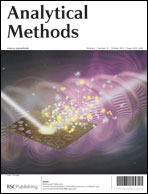An ultrasensitive electrochemical mercury(ii) ion biosensor based on a glassy carbon electrode modified with multi-walled carbon nanotubes and gold nanoparticles
Abstract
In this work, we describe the fabrication of an ultrasensitive electrochemical biosensor for the determination of the mercury(II) ion (Hg2+) in aqueous solution. The biosensor is based on a glassy carbon electrode (GCE) modified with


 Please wait while we load your content...
Please wait while we load your content...